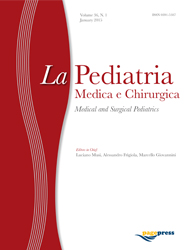Articles
31 October 2012
Vol. 34 No. 5 (2012)
Laparoscopic treatment of UPJ obstruction in ectopic pelvic kidneys in children
Publisher's note
All claims expressed in this article are solely those of the authors and do not necessarily represent those of their affiliated organizations, or those of the publisher, the editors and the reviewers. Any product that may be evaluated in this article or claim that may be made by its manufacturer is not guaranteed or endorsed by the publisher.
All claims expressed in this article are solely those of the authors and do not necessarily represent those of their affiliated organizations, or those of the publisher, the editors and the reviewers. Any product that may be evaluated in this article or claim that may be made by its manufacturer is not guaranteed or endorsed by the publisher.
1223
Views
1137
Downloads
Authors
Pediatric Surgery, Second University of Naples, Napoli, Italy.
Pediatric Surgery, Second University of Naples, Napoli, Italy.
Pediatric Surgery, Second University of Naples, Napoli, Italy.
Pediatric Surgery, Second University of Naples, Napoli, Italy.
Pediatric Surgery, Second University of Naples, Napoli, Italy.
Pediatric Surgery, Second University of Naples, Napoli, Italy.
Pediatric Surgery, Second University of Naples, Napoli, Italy.
How to Cite
PAGEPress has chosen to apply the Creative Commons Attribution NonCommercial 4.0 International License (CC BY-NC 4.0) to all manuscripts to be published.







